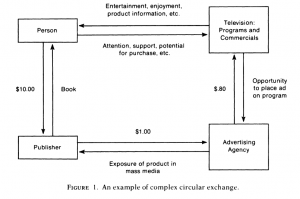Marketing as Exchange
Source:
Marketing as Exchange
Richard P. Bagozzi
The Journal of Marketing
Vol. 39, No. 4 (Oct., 1975), pp. 32-39
Published by: American Marketing Association
Article Stable URL: http://www.jstor.org/stable/1250593
——
Recall in Chapter 12 the overview of power in social networks and the research area in sociology know as network exchange theory. The book offers us a brief introduction to the “ways in which social imbalances and power can be partly rooted in the structure of the social network” (Easley and Kleinberg, 302). I’d like to expand a bit more on this theory, and then to offer some unconventional applications of sociology in the realm of business administration.
First, what are the different types of exchanges that can occur between actors? There are generally three types: restricted, generalized, and complex.
Restricted: Restricted exchange is a very common relationship that we have been exposed to in class exercises. Graphically, it can be represented as A « B, and involve two parties who engage in reciprocal relationships. Let us apply the restricted exchange definition to business. This occurs in common daily interactions between customer and sales personnel, wholesaler and retailer, etc. The key factor that makes restricted exchange interesting is the natural development of “mutual reciprocal relations” – the need to maintain equality. Though this may not necessarily be a critical dimension of exchange in, for example, a one-time transaction between you and an employee at the Starbucks at the JFK airport, it is quite different in the case of you as a customer and the sales associate at your favorite department store. Cultivating relationships is one of the intangible proponents for consistent future sales (I say intangible in the sense that it is more of a psychological and social effect, rather than an explicit seasonal store-wide sales event that guarantees a spike in sales transactions).
Generalized: These types of exchanges occur when “social actors form a system in which each actor gives to another but receives from some other than to whom he gave” (Bagozzi, 33). Symbolically, we can write generalized exchanges as A –> B –> C –> A.
Complex: A complex exchange can be seen as a hybrid of restricted and generalized exchange. Complex exchange “refers to a system of mutual relationships between at least three parties,” denoted A <–> B <–> C (Bagozzi, 33). It is complex in the sense that it is organized by not just a singular connection but also a web of interconnected relationships. Let’s look at Figure 1 for an example.
Here the network is not only complex (multiple “restricted exchanges” occur between more than two parties), but also “circular.” Now I would like to pose the question: Can an exchange occur by definition, between a person and a television program, when no tangible object is involved? Let’s break these exchanges down individually and analyze the indirect effect of an intangible exchange upon tangible ones.
Beginning with the person watching television, he gives his attention to the television program (including commercials) for entertainment or information. The television program then engages in an exchange with an advertising agency, where the advertising agency pays the television program $0.80 per commercial air timeslot. The advertising agency had previously participated in a similar exchange with a book publisher, receiving a commission of $1.00 for its publicity services. All these exchanges discussed have been direct. Indirect network effects occur when exchanges bridge or cross “sides” of a network, or in everyday application distinct markets or industries. In this example the initial direct exchange of intangibles between the person and the television is the catalyst for the generalized (indirect) exchange of the publisher’s book for $10. Recall that in a generalized exchange, we have a series of exchanges where Publisher ® Advertising Agency ® Television Program ® Person ® Publisher. Intuitively we can follow the steps it takes for the book to ultimately reach the person, and this series of exchanges can only occur if there is first a direct exchange of intangibles between the person and the television program.
Thus, we can see how crucial a role network analysis plays for marketing and advertising purposes. It is important to map out not only direct exchanges of money for objects, but also direct exchanges of intangibles and resulting indirect network effects. Business-minded individuals working in marketing must “attend to more than the relatively superficial facts with which they usually concern themselves when they do not think of their goods as having symbolic significance” and recognize that “people buy things not only for what they can do, but also for what they mean” (Bagozzi, 36).
Finally, I’d like to conclude my discussion and leave the readers with a hypothetical thought experiment. I’ve introduced network exchange theory in the context of advertising and marketing strategies, but where else could we identify the potential for this analysis in the realm of business? With the growing concern that a liberal arts background has no place in a pre-professional world, can we find a definitive link between the sociological theories of network exchange and business administration?
I’m happy to see that the American Marketing Association has already begun to educate its marketers about network exchange theory. So to answer the questions I posed above, I see perhaps the best fit and potential for network analysis, specifically matching markets, in the field of consulting. Let us consider human capital consulting. If a particular firm is experiencing inefficiency within its infrastructure, a consultant could use matching markets to essentially identify optimal matching of jobs with employees. She could evaluate and assign relative “prices” to create a preferred-seller graph to maximize the total valuation of the overall assignments. We’d then have a socially optimal, “market-clearing” perfect matching and have a proposal for the firm to improve their human capital structure.
I’d love to hear everyone else’s thoughts!

